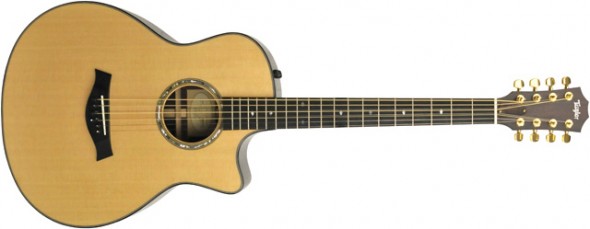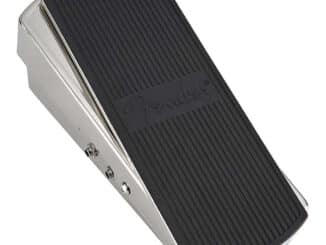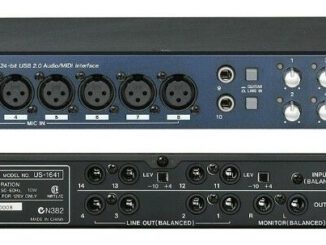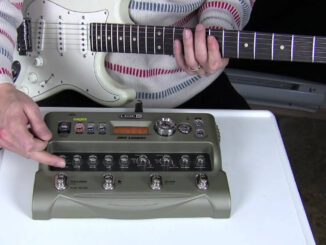
Taylor Guitars are known for creating breakthrough products, such as its New Technology neck and Expression System electronics. Many progressive building techniques, like using CNC milling machines and laser cutters for precision woodworking , or applying UV-cured finishes that are buffed to perfection by a nimble robot, were introduced or refined by Bob Taylor and his crew. While building beautiful instruments, Taylor has also altered long-held notions about luthiery.
But with the Baritone 8-String, the folks at Taylor have gone one step further: They’ve invented a new instrument. Combining a baritone’s long-scale fretboard and lowered tuning with selected octave strings from an acoustic 12, this Taylor is a guitar unlike any other. The concept sounds radical, but once you’ve played this configuration of tuning and strings, you’ll wonder why no one thought of it before. To fully grasp what’s going on with the Taylor Baritone 8-Strings, it helps to review some background info.
What’s a baritone?
A baritone’s scale length–the distance between the nut and saddle-differentiates it from a regular guitar. Because baritones have a longer scale, they can handle thicker strings and be tuned lower–typically a fourth below standard tuning or B, E, A, D, F#, B (low to high)–and still have essentially the same tension as a regular guitar. Even more important, the longer scale allows baritones to intonate correctly. (If you put heavy strings on a standard guitar and tune it a fourth lower the sixth string won’t intonate properly.) Baritone scale lengths range from just shy of 27” to as long as 29-¾”.
Although a baritone is tuned lower, the string-to-string intervals remain the same as on a standard guitar, which allows you to transfer all your hard-won chord voicings and lead lines directly from one instrument to the other. Clamp a capo on the fifth fret of a B-B baritone, and you’re back at standard guitar pitch. You can view the baritone as a way to extend the guitar’s fretboard five frets further down into the bass realm.
The Baritone 8-String
Boasting Taylor’s Grand Symphony body style–a design renowned for its volume and projection–the Baritone8-String has a 27” scale length and is tuned B-B. It ships with Elixir Baritone strings, gauged .016-.070. What makes this baritone special are the two octave strings on A and D–the fourth and third strings. As on an acoustic 12-string, the plain, high-octave strings (gauged .014 and .012) are simultaneously fretted and plucked with their wound mates. These octave pairs look and feel like the A and D pairs on a Taylor 12-strings, except they run down the middle of the fretboard.
 The Baritone8-String sports Taylor’s Expression System, which consists of three magnetic pickups (two internally attached to the soundboard and one mounted beneath the fretboard extension) and a preamp, and comes in a plush-lined hardshell case that’s as beautiful as it is robust.
The Baritone8-String sports Taylor’s Expression System, which consists of three magnetic pickups (two internally attached to the soundboard and one mounted beneath the fretboard extension) and a preamp, and comes in a plush-lined hardshell case that’s as beautiful as it is robust.
Taking a test drive
I was immediately impressed by the Baritone8-String’s playability. As an owner of a four baritones (three electric and one acoustic, with scale lengths ranging from 27-¾” to 29-¾”), I know it can be a challenge on some models to fret even partial barre chords in the lower positions. Not so on the 8-Strings. By keeping the scale length at 27”–long enough to let the low B develop a big, rich twang, but on the short side of the baritone range–Taylor has made it easy for guitarists to transition into the baritone world. The lowest frets are spaced only slightly farther apart than on a standard Taylor GS, so you’ll feel right at home playing open-string and barre chords in the first three or four positions. Measuring a finger style-friendly 1-¾” at the nut, the neck is also the same width as Taylor’s GS 6-string models, so it feels familiar as well.
What’s different is the sound. This baritone has a burly growl topped with a delightful shimmer provided by the octave pairs. These octaves blend into strummed chords and finger picking-passages, adding definition to the guitar’s upper midrange with-out masking its low-end twang. Baritones can sound dark–even muddy–when strummed, but the harder you hit the Taylor 8-String, the more it sparkles. With its lowered tuning and lightly chiming octaves, this guitar sounds more like a piano than any other I’ve heard. If you’re a songwriter or if you accompany a singer, you’ll welcome the ringing power the Baritone8-String brings to your voicings.
This bari croons
And though it makes a superb rhythm instrument, the 8-String isn’t limited to that role. You can approach the 8-String Baritone as a lead guitar with distinct sonic personalities. If you play lines along the top two plain strings, you can bend and slur just like on a 6-string flattop. Plucking the tow lowest strings lets you explore a cello register–perfect for bass runs and driving riffs. But travel up and down the two octave pairs, and listeners will swear they’re hearing a 12-string. The fun begins when you explore ways to combine these different elements.
Deep satisfaction
Played acoustically or amplified, the 8-String has a bold, assertive voice, and its immaculate interior bracing, fretwork, and finish are equally impressive. If you’re looking for inspiring new sounds from a guitar that will turn heads whenever you play it, you need to experience the Taylor Baritone 8-String. Check for price.
Musician’s Friend





Be the first to comment